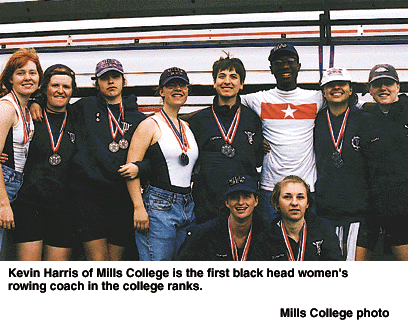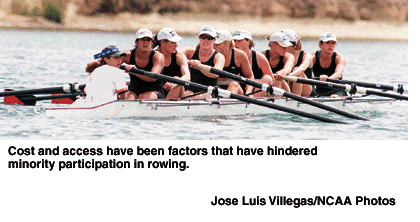The NCAA News - News and FeaturesApril 27, 1998
Seeking a diverse crew
Mills College looked beyond the usual places in its effort to find the first NCAA African-American rowing coach
BY GARY T. BROWN
STAFF WRITER
 Here's a brain teaser: (1) Mills College is a Division III women's school in Oakland, California. (2) Rowing is a sport with primarily white ethnic roots. (3) Kevin Harris is an African-American graduate of George Washington University. (4) Kevin Harris is Mills' head rowing coach.
Here's a brain teaser: (1) Mills College is a Division III women's school in Oakland, California. (2) Rowing is a sport with primarily white ethnic roots. (3) Kevin Harris is an African-American graduate of George Washington University. (4) Kevin Harris is Mills' head rowing coach.
What's wrong with this picture?
Absolutely nothing, according to Mills athletics director Helen Carroll, except that there aren't more pictures like it around the country.
Harris appears to be the lone black head rowing coach in the college ranks, which to some may be a tiny factoid on the athletics radar screen, but to others it's a wake-up call for diversity.
Rowing is one of those sports that has pockets of popularity, rooted historically in the Ivy Group tradition, with additional enclaves on both coasts. As with golf, tennis and swimming, participation numbers are on the rise, but not due to an influx of minorities.
That's why Harris' hiring at Mills produced a shock wave of sorts in the rowing community, one that has been positively received. It certainly was a hit with the Mills rowing team -- in fact, it may not have happened without them.
When the head rowing job opened up at Mills last year, Carroll spoke with the team as she does before each coaching hire she makes.
There was the usual discussion about finding someone who could take an already strong program to the next level, someone with qualities Carroll sought with any candidate -- leadership, mentorship, the ability to nurture and educate.
But there was another piece of the puzzle, according to the student-athletes. They told Carroll that they couldn't figure out why there weren't any coaches of color at all the regattas they had attended.
Putting the word out
That hit home with Carroll, who is recognized for her work on homophobia and diversity issues. She hadn't seen much color at the rowing helm either. And she didn't have an answer for team members when they asked if it was possible.
So she fired off inquiries to the Black Coaches Association. She checked the NCAA's minority vita bank. She called the Women's Sports Foundation and put the word out to various minority groups in order to compile a truly diverse applicant pool.
But it was the coach she was replacing who knew of a guy at Mount Holyoke who might be the perfect fit.
That guy was the 28-year-old Harris, a former coxswain at George Washington who had spent a few years as a high-school rowing coach before taking over the novice team at Mount Holyoke.
"At first, I thought there would be no way I could find a person of color to come in and do this job," Carroll said. "I was well aware that there was a lack of role models for minorities in rowing. So we sought out Kevin, and his working at Mount Holyoke told me that he was used to coaching women and working at a small women's college -- so he already had some of the qualities that you usually have to learn when you come here."
 The reaction from the team?
The reaction from the team?
"They were more surprised that I was male," said Harris, who in addition to being a national trailblazer in race is a Mills trailblazer in gender.
"It's kind of sad that I'm the first (black coach). In terms of being a coach, my record is pretty comparable but nothing amazing -- about what you'd expect from someone at this point in his or her career.
"But I don't want to be held up as the Great Black Hope. That puts a lot of pressure on me as an individual, and there's nothing particularly remarkable about me as a coach. If I were a white male coach, you wouldn't be talking to me. There are a lot of outstanding white male coaches who have done a great job with their crew teams who deserve to be in The NCAA News as much as anyone."
A lack of access
Harris offered several reasons for rowing's dearth of diversity -- primarily the sport's Ivy Group roots and the lack of access to people of color.
"For a long time, women weren't in the Ivy Group and there weren't a lot of minorities either," he said. "If people rowed outside the Ivy, they did it at high schools like Andover or some of the other Eastern prep schools. It's really only been in the last 15 to 20 years that it's been available to a more diverse population."
Harris was hooked to the sport as a youth, impressed by an article he saw in National Geographic. His rowing team in Alexandria, Virginia, was free to anyone who could pass the swim test and there were no cuts.
It's that kind of access, Harris said, that isn't often there for minorities.
"Who can afford $400 a semester to be on a high-school rowing team? And a lot of kids can't get scholarships because who knows -- they didn't row in high school -- they look like great athletes but a coach won't give a scholarship to someone who hasn't proven herself, so it's sort of a cycle."
Harris mentioned various rowing programs that target minorities -- one in Oakland, in fact -- but often kids from the suburbs hear about the programs and take up the spots.
Then there's the problem of access to the water. Harris said that's difficult even for the wealthier communities. And once you have access, there's the issue of a boathouse and boats. Harris noted that Mills spent $16,000 for a used shell this year.
"Imagine a community rowing club in a minority area trying to start a crew team," he said.
"I'd love to run a program out of my boathouse, but I'm not allowed by the water-use rules and the fact that the boathouse is 20 minutes away from the population I'd like to serve. I know a lot of coaches who have established their rowing teams will say they don't want rowing to be an all-white exclusive thing -- they want to include the campus. And there are all kinds of reasons why this hasn't happened. We have this trouble in a lot of sports, not just rowing. Look at swimming. There's all kinds of access, but we're not able to get a lot of minorities to the pool because it's not a place where they go."
Emerging sports
Rowing was an emerging sport two years ago, which meant that institutions were allowed to use rowing to help meet the NCAA minimum sports-sponsorship requirements and the NCAA's minimum financial aid awards. The goal is to provide additional athletics opportunities for women, but ironically, emerging sports (women's ice hockey and women's water polo are the next likely candidates) are actually diluting the overall participation numbers for minorities.
"There really has never been any justification of why certain sports were identified as emerging sports," said Charles Whitcomb, faculty athletics representative at San Jose State University and chair of the NCAA Minority Opportunities and Interests Committee. "What's happened is that these sports have basically perpetuated the exclusivity that's currently there because they are sports that most people in minority communities do not participate in -- they're traditionally very white, middle-class sports."
Harris said that while he's noticed a slight influx of minority participation in rowing, diversity in the sport may not yet be enough of a priority in general.
"Administrators want rowing, but they don't pay attention to it because they don't know that much about it," he said. "The issue of who's on the team often doesn't even occur to people."
It did to Carroll, who wanted her staff to more represent the ethnicity of the campus.
If nothing else, Harris represents the notion that qualified minority candidates are out there even in nontraditional sports -- if you look hard enough.
"It takes time and effort for the person doing the hiring," she said. "You can't just take a list of things and send out some job announcement and expect to get a highly qualified pool. You have to get on the phone and talk to people, find out who's out there and then you have to talk with people of color so that they know it's a good place for them to come. It takes a lot of time and effort to do that.
"Sometimes you get into a pattern of how things run smoothly -- and change is hard -- and a lot of people in hiring positions don't take the time or effort to shake things up in order to change the look of an organization."
"It does take extra work," Whitcomb said. "I've never bought that you can't find anybody. You certainly can't if you don't work hard enough.
"Traditionally, we in athletics have taken the path of least resistance. We've gone about identifying perspective candidates for positions in very traditional ways, and we haven't necessarily extended ourselves beyond the box. In this case, Helen Carroll extended herself beyond the box and that's what it takes. That's the kind of effort we all have to make if we're going to make a difference."
|